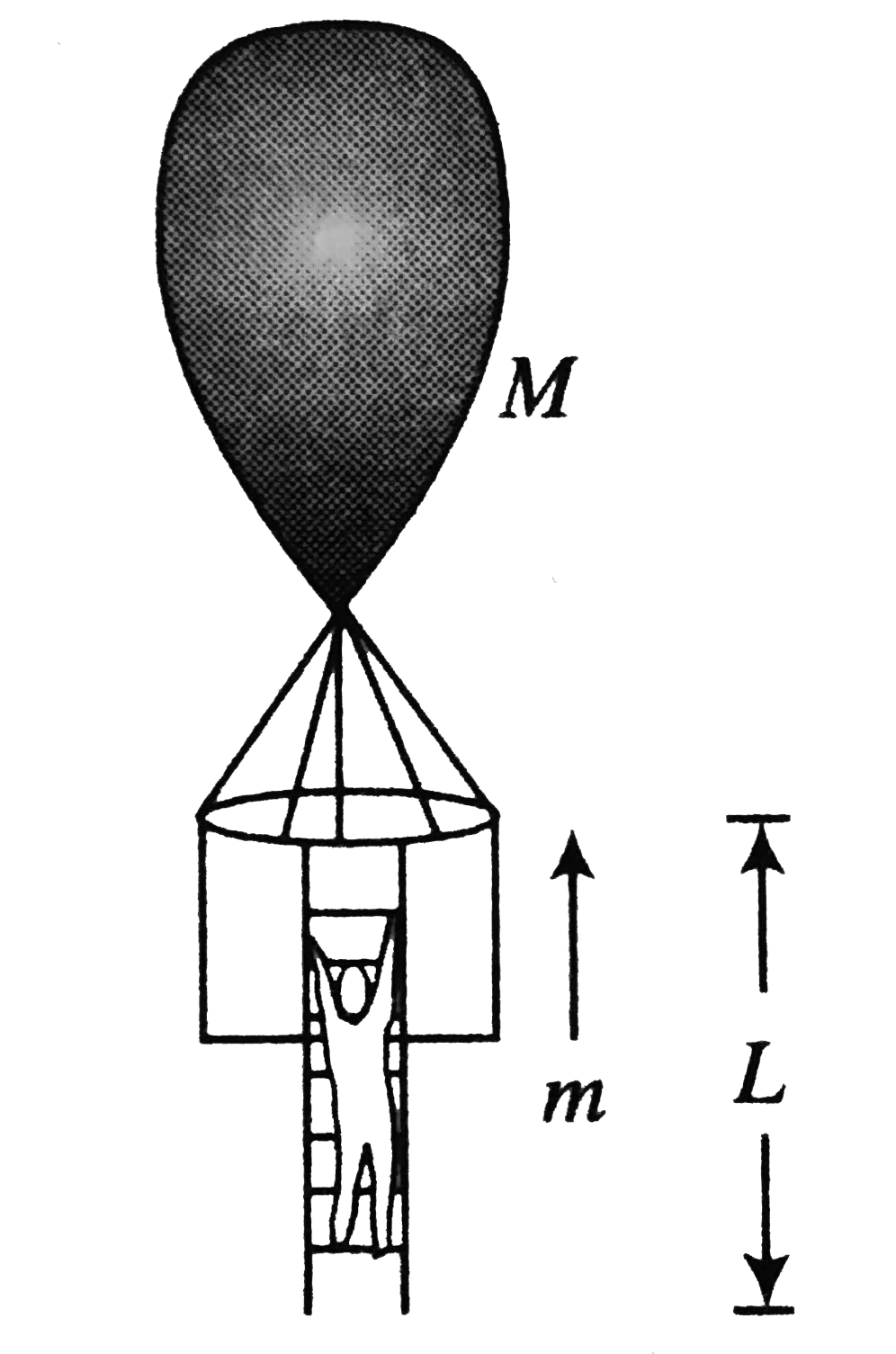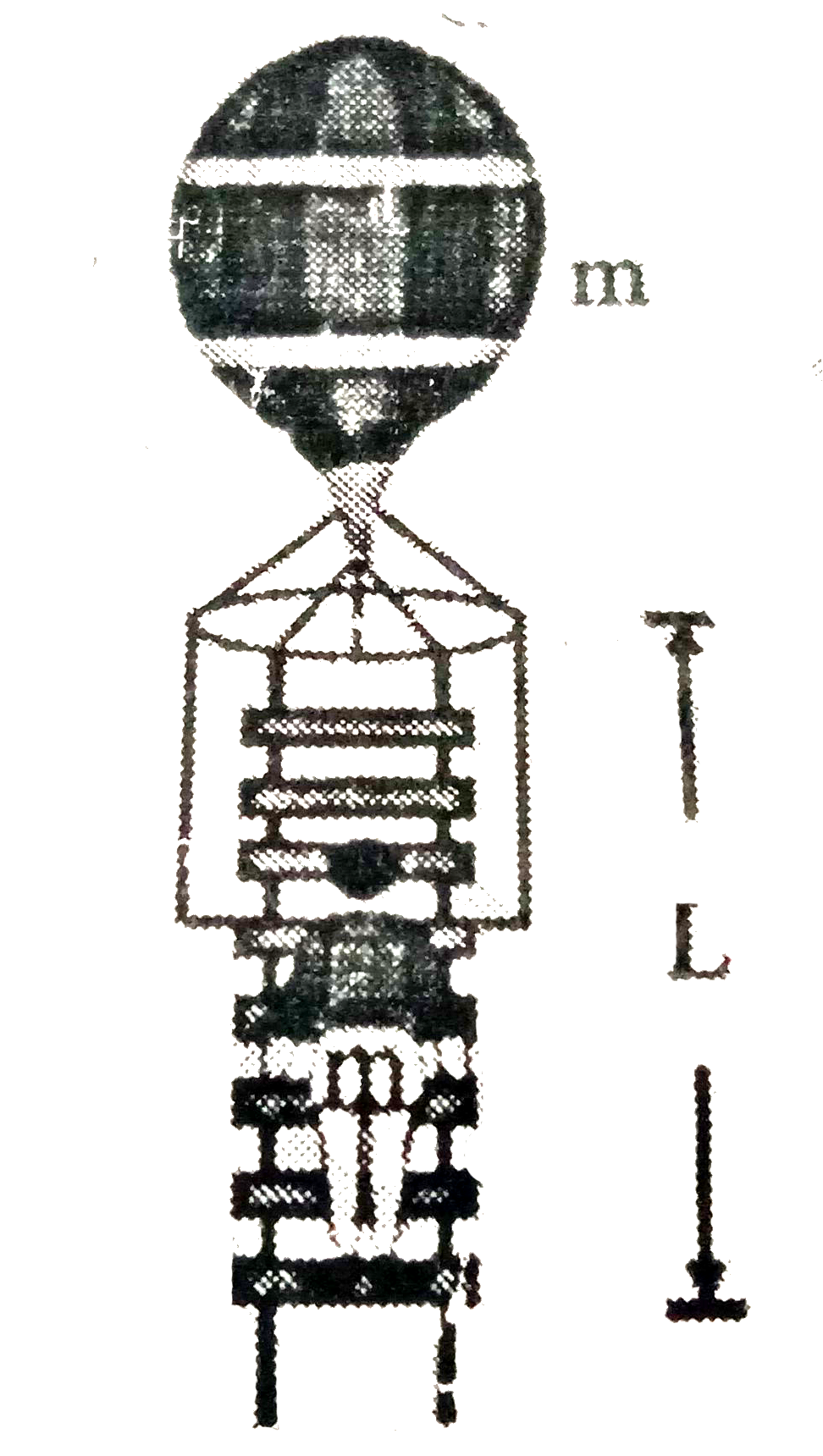A rope ladder of length L is attached to a balloon of mass M. As the man of mass m climbs the ladder into the balloon basket, the balloon comes down by a vertical distance s. Then the increase in potential energy of man divided by the increase in potential energy of balloon is

L−ss
Ls
sL−s
L−s
The correct Answer is:A
Work done by man, mgL=mg(L−s)+mgs
where mg(L−s) is the increase in potential energy of the man and mgs is the increase in potential energy of the balloon because the balloon would have been lifted up but for the climbing of the man. So
Increase in PE of man/Increase in PE of balloon=mg(L−s)mgs−L−ss
Topper's Solved these Questions
- WORK, POWER & ENERGYBOOK - CENGAGE PHYSICSCHAPTER - WORK, POWER & ENERGYEXERCISE - Multiple Correct
25 Videos
- WORK, POWER & ENERGYBOOK - CENGAGE PHYSICSCHAPTER - WORK, POWER & ENERGYEXERCISE - Linked Comprehension
55 Videos
- WORK, POWER & ENERGYBOOK - CENGAGE PHYSICSCHAPTER - WORK, POWER & ENERGYEXERCISE - Subjective
23 Videos
- VECTORSBOOK - CENGAGE PHYSICSCHAPTER - VECTORSEXERCISE - Exercise Multiple Correct
5 Videos
Similar Questions
A ladder of length l carrying a man of mass m at its end is attached to the basket of a balloon of mass M. The entire system is in equilibrium in the air. As the man climbs up the ladder into the balloon, the balloon descends by a height h.
The potential energy of the man
View SolutionA man of mass 50 kg climbs up a Indder of height 10 m. Calculate : (i) the work done by the man and (ii) the increase in his potential energy (g = 9.8 ms2)
View Solution
Knowledge Check
A rope ladder of length L is attached to ballon of mass m. As the man of mass m clims the ladder in to the lballon basket the ballon comes donws by a vertical distance s. Then increase in potential energy of man divided by increase inn potential energy of ballon is
 AL−ssBLsCsL−sDL−s
AL−ssBLsCsL−sDL−sA ladder of length l carrying a man of mass m at its end is attached to the basket of a balloon of mass M. The entire system is in equilibrium in the air. As the man climbs up the ladder into the balloon, the balloon descends by a height h.
The potential energy of the balloonA(a) Decreases by mghB(b) Increases by mghC(c) Increases by mgl(l−h)D(d) Increases by mglA ladder of length l carrying a man of mass m at its end is attached to the basket of a balloon of mass M. The entire system is in equilibrium in the air. As the man climbs up the ladder into the balloon, the balloon descends by a height h.
The potential energy of the manA(a) Increases by mg(l−h)B(b) Increases by mglC(c) Increases by mghD(d) Increases by mg(2l−h)
A ladder of length l carrying a man of mass m at its end is attached to the basket of a balloon of mass M. The entire system is in equilibrium in the air. As the man climbs up the ladder into the balloon, the balloon descends by a height h.
The work done by the man is
View SolutionA stick of mass m and length l is pivoted at one end and is displaced through an angle θ. The increase in potential energy is

View SolutionA person of mass m is hanging from a rope fastened to a stationary balloon of mass M If the person climbs the rope , then with what velocity the balloon would move and in what direction ?
View SolutionA ladder of length l carrying a man of mass m at its end is attached to the basket of a balloon of mass M. The entire system is in equilibrium in the air. As the man climbs up the ladder into the balloon, the balloon descends by a height h.
The work done by the man is
View SolutionA stick of mass m and length l is pivoted at one end and is displaced through an angle θ. The increase in potential energy is

View Solution
